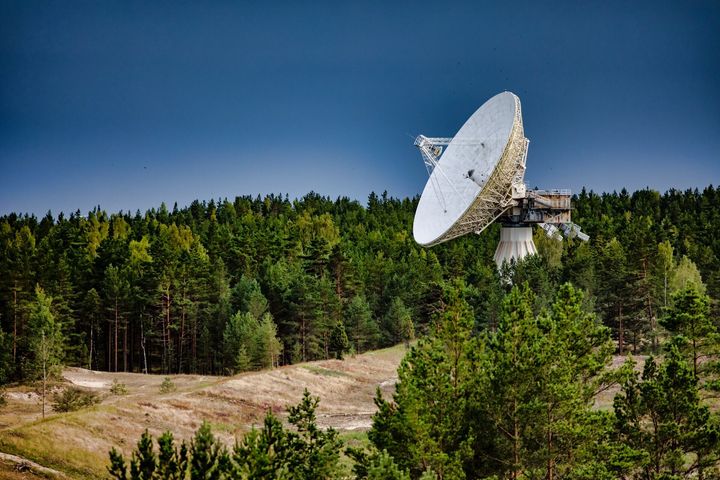This web page is created within BALTICS project funded from the European Union’s Horizon2020 Research and Innovation Programme under grant agreement No.692257.
About VIRAC.
Insight into history
- Irbene radioantenna complex was founded on June 10, 1967, as a secret Soviet astronomy and communications center to spy communications in the west.
- VIRAC, was founded by the Latvian Academy of Sciences under the name Ventspils International Radio Astronomy Center on July 22, 1994, when the State Commission from the Russian Federation took over from the former Soviet Union, at the time of the transfer, the Russian Federation’s military unit at Irbene, in the Ventspils region (military object “Star”).
- Two years later, VIRAC was reorganized as a state-owned scientific non-profit organization, a limited liability company.
- On December 16, 2004, VIRAC was included in the Ventspils University College (now Ventspils University of Apllied Sciences – VUAS) as the VUAS Scientific Institute, which was registered on November 25, 2005 in the Register of Scientific Institutions of the Republic of Latvia.
- On March 1, 2010, VIRAC added a second VUAS scientific institute – the Engineering Research Center (IPC), replacing the name of the institute to the current one.
- On March 18, 2010, the VIRAC as a VUAS unit was re-registered in the Register of Scientific Institutions of the Republic of Latvia.
- In 2013, the VIRAC became a VUAS unit with its Scientific Council, whose activities are determined by the Senate of the VUAS.
- In 2016, VIRAC was admitted to the European Radio Astronomy Observation Network (EVN) and Latvia – JIV-ERIC.
- In 2019, VIRAC became a member of ILT.
Engineering Research Institute Ventspils International Radio Astronomy Centre (ERI VIRAC) of Ventspils University of Applied Sciences (VUAS) is a science education center specializing in the implementation of high-quality future research services in the field of space technology and signal processing.
The strategic goal of ERI VIRAC is to become a global provider of research services in the field of astronomy and space technology, to create an internationally competitive, balanced and sustainable team of researchers as well as an internationally competitive and demanding research infrastructure for science infrastructure.
The Irbenes radio telescope is equipped with two completely rotatable, parabolic antennas “RT-32” and “RT-16”.
Overview about VIRAC and ongoing activities
- Ventspils International Radio Astronomy Centre (VIRAC) of Ventspils University of Applied Sciences (VUAS) was established in 1994 with the aim to develop the research activities in radio astronomy, astrophysics and space sciences. The most important instrumental base for the centre comprised two fully steerable parabolic antennas, RT-16 and RT-32 (i.e., with the mirror diameter of 16 m and 32 m) and LOFAR-LATVIA station. The intensive reconstruction and instrumental refurbishment carried out in 2014 – 2019 made it possible to use radio telescopes for the international scale fundamental and applied research in the field of radio astronomy. The most important aspect of this work is participation in the VLBI (Very Long Baseline Interferometry) international experiments.
- During the renovation, radio telescopes were instrumented with two channel right circular polarization (RCP) and left circular polarization (LCP) cryogenic broad band receivers with frequency coverage of 4.5 – 8.8 GHz and instantaneous bandwidth of approx 1200 MHz.
- Receivers are cryogenically cooled to 14 Kelvin which nominally achieves system noise temperatures of 30 to 50 Kelvin throughout the whole bandwidth. A secondary receiver is available at RT-32 for observations at 1.40 to 1.72 GHz. It is an uncooled receiver with dual (RCP and LCP) polarization channels and achieves system temperatures of 60 to 100 K. Each telescope has VLBI equipment available, which includes Active Hydrogen masers, DBBC/Mark5c/FlexBuff data registration back-ends and 10 Gbit optical fibre network. Maximum azimuth and elevation tracking velocities are up to 5 degrees/s with RMS tracking accuracies 4 arcsec allowing to track Near Earth satellites.
- Additionally, radio telescope RT-32 performs routine spectral polarimetric observations of the Sun by the multi-channel (16 frequency channels) spectral polarimeter for the wavelength range 3.2 – 4.7 cm (6.3 - 9.3 GHz) and both circular polarizations. The new multi-channel spectral polarimeter, installed in 2022 is expected to observe right and left circular polarization of the solar emission in the wavelength range 2.1 – 7.5 cm (4.1 – 14.3 GHz) divided into 12 frequency bands. The dynamic range of the receiver is up to 36 dB; the signal/noise ratio (referred to quiet Sun brightness temperatures) is 22-24 dB.
- The LOFAR-Latvia is an international LOFAR station. It contains 96 low band (LBA) (10 - 90 MHz, total area 3200 sq.m) and 96 high band (HBA) (110 - 240 MHz, total area 2400 sq.m) antennas.
- One of the main scientific objectives for the VIRAC centre is VLBI observations in centimetre and metre wavelengths in collaboration with the global VLBI networks, such as European VLBI network (EVN), LOFAR, IVS and others. The new receiving and recording systems provide a high stability of the time frame, which is a prerequisite for the VLBI observations. Since October 2015 VIRAC radio telescopes have regularly taken part in international VLBI sessions. VIRAC is a member of pan-European networks such as CERN (Member State since 2021), International Low Frequency Array (LOFAR) Telescope (ILT) since 2019, European VLBI (EVN) and JIV-ERIC networks since 2016.
- In its fast evolution, the VIRAC does not stop only in radio astronomy and astrophysics, and today the centre also encapsulates strong scientific groups in satellite communication, space technologies, remote sensing and high-performance computing. VIRAC's main ambition is to become a part of the European Space Industry with Ground Segment services based on adaptation and sharing of infrastructure model providing maximum benefit on European and Global scale for both Space Missions and Fundamental Research in Radio Astronomy. VIRAC is carrying out this task by providing research, educational and commercial services of high quality and client driven approach, in close cooperation with European Space Agency (ESA) and with other key players in the global space industry.





















